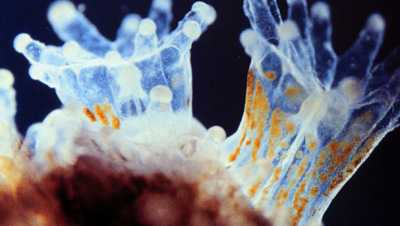 |
| Zooxanthellae in coral polyps [1] |
Zooxanthellae are endosymbionts that are best known for giving coral reefs their vibrant colors. Coral reefs are calcareous structures that support a wide diversity of marine flora and fauna. It is a “marriage” of convenience for both parties involved: a great example of mutualism. They live exclusively in scleractinian coral species, reef building corals.
Distribution
Warm waters and light limit coral reefs. Thus, the corals are generally
found in tropical shallow waters. Coral reefs exist in the Caribbean, the
Indian Ocean, and the tropical Pacific. In addition, where one finds corals, one
finds zooxanthellae as well. [2] However, some of the zooxanthellae
are host specific.
Coral Life Cycle
 |
| [2] |
Corals exist as an adult polyp which undergoes sexual reproduction
through the release of gametes to form the zygote. The zygote then enters the
free swimming state called the planula larva stage, which settle on a substrate
and develop into a poly and restarts the cycle. [2] The adult polyp are
of a tubular shape with a gastrovascular cavity and a ring of tentacles. An
individual polyp secretes a skeleton called corallite and is composed of calcium
carbonate in the form of aragonite. [2]
Zooxanthellae Life Cycle
Zooxanthellae begin as an immature cyst which turns into a mature cyst
that divides. After division it evolves into the zoosporangium. After which,
the zoosporangium enters a free-swimming form called the zoospore. From here
gametes develop and released upon maturation, and the cycle begins again. [3]
A Relationship of Old
Zooxanthellae are a type of dinoflagellate belonging to the genus
Symbiodinium while reef building corals belong to the phylum Cnidaria, class
Anthazoa, subclass Hexacorallia, and order Scleractinia. Originally
scleractinian corals were not reef building corals and preferred the solitary
existence. However, about 230 million years ago in the Triassic period a
symbiotic relationship was established between zooxanthellae and scleractinian
corals. [4] The corals can acquire the zooxanthellae by ingestion in
their larval stage. However, they can be acquired by vertical transmission from
the parent.
Reasons to Stay Married
 |
| [5] |
The relationship is that of an obligate mutualism. Without
the zooxanthellae corals cannot form reefs. Both parties benefit from the
association. The zooxanthellae provides
glycerol, glucose, alanine, and oxygen to the coral polyp. In addition, it
facilitates the deposition of calcium carbonate which is needed to from the
skeleton, as well as removing carbon dioxide and nitrogenous wastes. Meanwhile
the polyp provides nutrients to the zooxanthellae in the form of nitrogen and
phosphorous and UV protection. In the polyp the zooxanthellae finds a home and
protection from predation. [2]
Drawbacks
Every
relationship comes with a few restrictions. The zooxanthellae are the
reason for corals being limited to the euphotic zone since zooxanthellae can
only live at certain temperatures and light depth. In return the growth of the
zooxanthellae is limited within the coral in order to maintain a balance of
nutrient flow. When
the coral is unable to control the division of zooxanthellae, carbon is
diverted to the zooxanthellae instead of the coral, leading to the expulsion of
the zooxanthellae. This causes the coral to lose all color, leading to a
bleaching effect. [6]
[7]
It’s
All About Staying Alive
According
to Combes, mutualism is a form of reciprocal slavery and in this case that is
very much true. At the end of the day, it comes down to tradeoffs: geographic
limitations in exchange for the ability to form reefs, nutrients, and enhanced
growth in the case of the coral reef, while zooxanthellae obtains food,
shelter, and protection in exchanged for a more limited reproductive rate. In
this way, they both enslave the other. At the end of the day, the benefits outnumber
the cost of living separate and it becomes a case of “Live together or die
alone.”
[1]. http://serc.carleton.edu/images/eslabs/corals/polyp_with_zooxanthellae.jpg
[2] Smith,
Alan. “Coral Physiology.” Powerpoint presentation. February 2011.
[3] Steele, R. D. (1975). Stages in the life history of symbiotic zooxanthellae in pellets extruded by its host Aiptasia tagetes (Duch. and Mich.) (Coelenterata, Anthazoa). Biol. Bull. 149:590-600. Retrieved from
[5] http://www.greenchange.org/img/original/sp%20coral%20reef.jpg
[6] Woodridge, S. A. (2010). "Is the coral-algae symbiosis really mutually beneficial for the partners?".
BioEssays 32 (7): 615–625. Retrieved from
http://onlinelibrary.wiley.com/doi/10.1002/bies.200900182/pdf
[7] http://www.youtube.com/watch?v=u4R0FqkywxE
[7] http://www.youtube.com/watch?v=u4R0FqkywxE
No comments:
Post a Comment